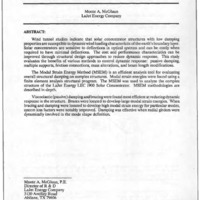-
Title
-
Methods Of Reduction Of Wind Induced Dynamic Response In Solar Concentrators And Other Small Lightweight Structures
-
Report Number
-
WL-TR-91-3078 Volume I, p. CCA-1 thru CCA-19
-
Creator
-
McGlaun, Monte A.
-
Corporate Author
-
LaJet Energy Company
-
Laboratory
-
Wright Laboratory
-
Date
-
1991
-
Date Issued
-
1991-08
-
Extent
-
19
-
Contract
-
Laboratory Research - No Contract
-
DoD Project
-
2401
-
DoD Task
-
240104
-
Identifier
-
ADA241311
-
Format
-
1 online resource
-
Abstract
-
Wind tunnel studies indicate that solar concentrator structures with low damping properties are susceptible to dynamic wind loading characteristic of the earth's boundary layer. Solar concentrators are sensitive to deflections in optical systems and can be costly when required to have minimal deflections. The cost and performance characteristics can be improved through structural design approaches to reduce dynamic response. This study evaluates the benefits of various methods to control dynamic response: passive damping, multiple supports, friction connections, mass alterations, and beam length modifications. The Modal Strain Energy Method (MSEM) is an efficient analysis tool for evaluating overall structural damping on complex structures. Modal strain energies were found using a finite element analysis structural program. The MSEM was used to analyze the complex structure of the LaJet Energy LEC 1900 Solar Concentrator. MSEM methodologies are described in-depth. Viscoelastic (passive) damping and bracing were found most efficient at reducing dynamic response in the structure. Braces were located to develop large modal strain energies. When bracing and damping were located to develop high modal strain energy for particular modes, system loss factors were notably improved. Damping was effective when radial girders were dynamically involved in the mode shape definition.
-
Description
-
Wind tunnel studies indicate that solar concentrator structures with low damping properties are susceptible to dynamic wind loading characteristic of the earth's boundary layer. Solar concentrators are sensitive to deflections in optical systems and can be costly when required to have minimal deflections. The cost and performance characteristics can be improved through structural design approaches to reduce dynamic response. This study evaluates the benefits of various methods to control dynamic response: passive damping, multiple supports, friction connections, mass alterations, and beam length modifications. The Modal Strain Energy Method (MSEM) is an efficient analysis tool for evaluating overall structural damping on complex structures. Modal strain energies were found using a finite element analysis structural program. The MSEM was used to analyze the complex structure of the LaJet Energy LEC 1900 Solar Concentrator. MSEM methodologies are described in-depth. Viscoelastic (passive) damping and bracing were found most efficient at reducing dynamic response in the structure. Braces were located to develop large modal strain energies. When bracing and damping were located to develop high modal strain energy for particular modes, system loss factors were notably improved. Damping was effective when radial girders were dynamically involved in the mode shape definition.
-
Distribution Classification
-
1
-
Distribution Conflict
-
No
-
DTIC Record Exists
-
No
-
Illinois Tech Related
-
No
-
Photo Quality
-
Complete
-
Report Availability
-
Full text available
-
Type
-
article
 article19
article19